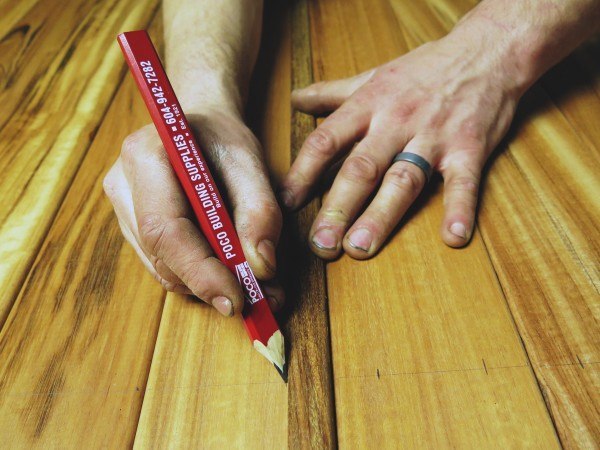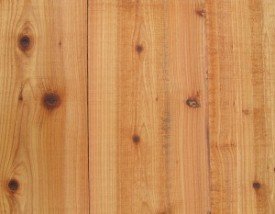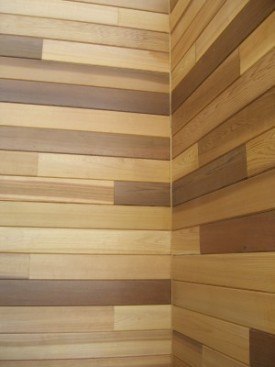Whether you’re installing clear cedar soffit, or building a brand new hardwood deck with exotic woods like Ipe, Tigerwood, Batu or Mukulungu – there is one thing that we can guarantee. Wood is not perfect.
If the main box that you need to tick when considering which product to use on your siding, deck or any other aspect of your home is consistency of colour then you should perhaps forget about natural fiber in favour of a synthetic product like Trex, TimberTech – but even then, asking for ’perfection’ is stretching the limits of expectations.
It’s important to acknowledge that all lumber that’s milled for the purposes of decorative, functional or structural application, was once a living organism – and each species has unique qualities and characteristics that make it suitable or unsuitable for a variety of uses.
WESTERN RED CEDAR
Let’s use Western Red Cedar (WRC) as our first example. Widely used for generations in its native Pacific Northwest, WRC has some attractive qualities for both interior and exterior applications. A natural resistance to rot and decay makes WRC ideal for decking, siding, and exterior wood features – and it’s warm tones not only provide warmth to your interior or exterior wood features in terms of its rich colour, but also to your home – as WRC is a fantastic, breathable insulator in siding applications.
Don’t expect uniform colour when it comes to this hardy species – as even with Vertical Grain (VG) Clear Grades, you will see varying tones within the Cedar palette from rich Orangey browns to more blonde – almost Pine-like streaks, in any given batch or mill-run.
Varying grades provide different characteristics:
ALTERNATIVES TO WESTERN RED CEDAR
Where consistency is the desired look – there are species of wood that offer a more uniform colour, with Clear Hemlock being a good example – but even then, you should expect there to be some difference between the tonality of each piece of wood. The draw-back here is that whilst Hemlock is suitable for Soffit application where weather and UV exposure is not a factor – it does not perform well on Siding or Decking as it does not posses the same characteristics as WRC, the true work-horse of the Pacific Northwest.
STAINING
We can also dispel another myth – that by applying a stain or wood finish you can make the colour consistent or uniform. Whilst this is somewhat true of opaque (solid) stains, where the clarity, colour and grain of the wood are blocked by the solid pigment in the stain or paint – in the case of translucent, transparent or semi-transparent stains, you should expect variation in colour. Each piece of wood may contain large or small areas that are more or less porous than others and therefore the colour can change dramatically from one end of a piece of wood to another depending on whether it is soaking into the fiber or sitting on the surface. Applying a wood stain will often enhance the colour, lustre and grain pattern of wood – and can often draw natural oils or tannins from within the wood that were not present on the surface in it’s raw state.
There is no rule of thumb here – other than to expect the unexpected. Colour swatches for interior or exterior wood stains should be used as a guide and testing for colour prior to batch finishing is a must to ensure that you – or you (or your client) are happy with the colour, variation and sheen level. It’s often good practise to do a brush out on several pieces of wood from a batch, to get an idea of the difference in tones that can occur.
HARDWOODS
Let’s now look at some Hardwood species that are increasingly being used for Decking and other exterior wood features due to their density, durability and potential low-maintenace and longevity when compared to WRC
Ipe (pronounced ‘ee-pay’)
Perhaps the most desirable of the four species of Hardwoods we supply, Ipe’s rich tones, tight grain, natural durability and density offer some attractive benefits when used outdoors for decking, railing and outdoor furniture. In terms of colour – Ipe Decking is considered to be the most durable, stable and consistent in colour, but as planks to comprise a deck may be cut from several different trees, it can and will range in colour from more characteristic mahogany and teak like browns, to sometimes green, purple or red tones. To preserve the colour of Ipe – or bring back after greying, use a combination of Penofin’s First Step Prep for Hardwoods and Penofin Hardwood Formula. Click the link to find out more about these products as well as other Hardwood Decking Essentials.
JANKA HARDNESS
|
BENDING STRENGTH
|
LIFESPAN
|
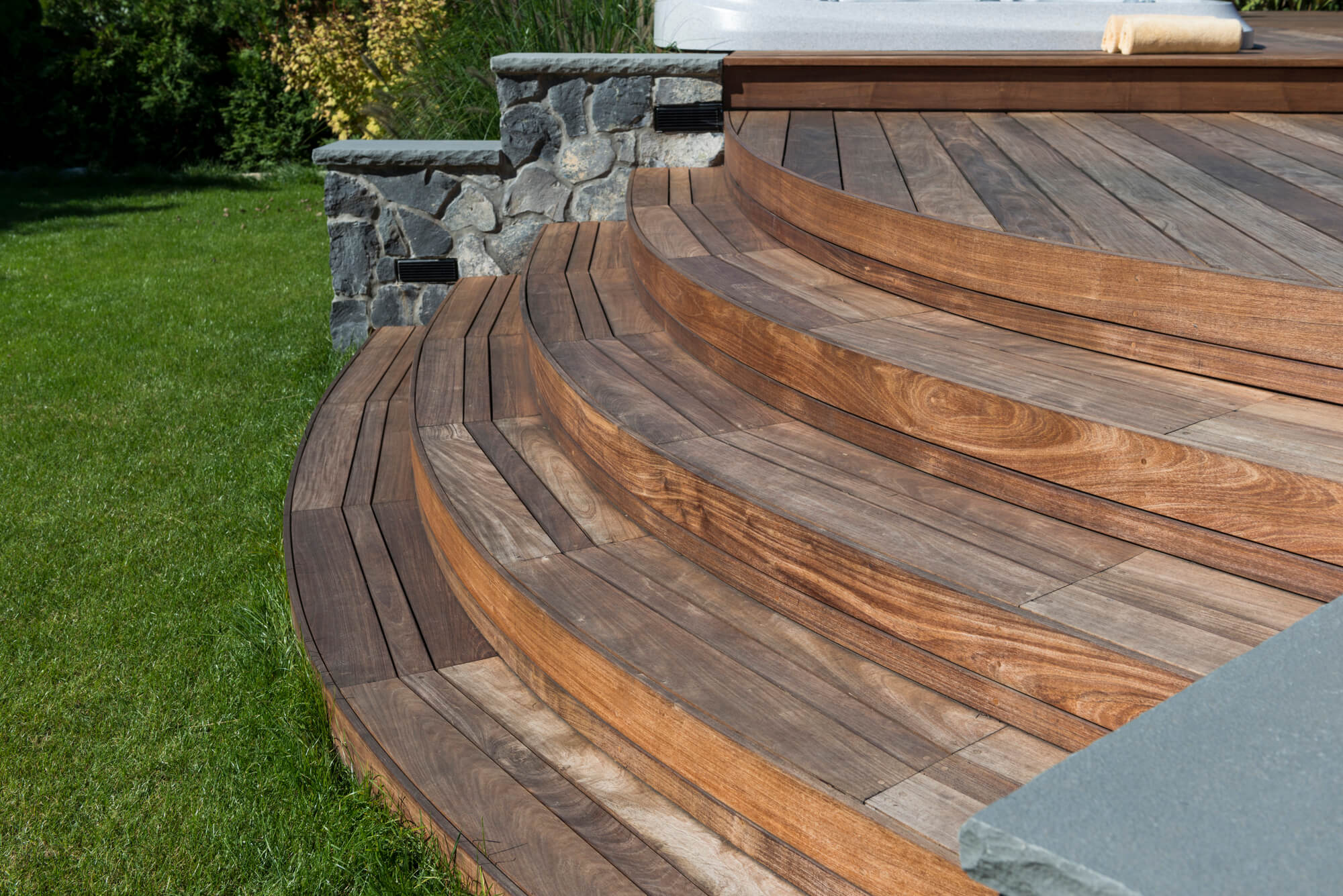 |
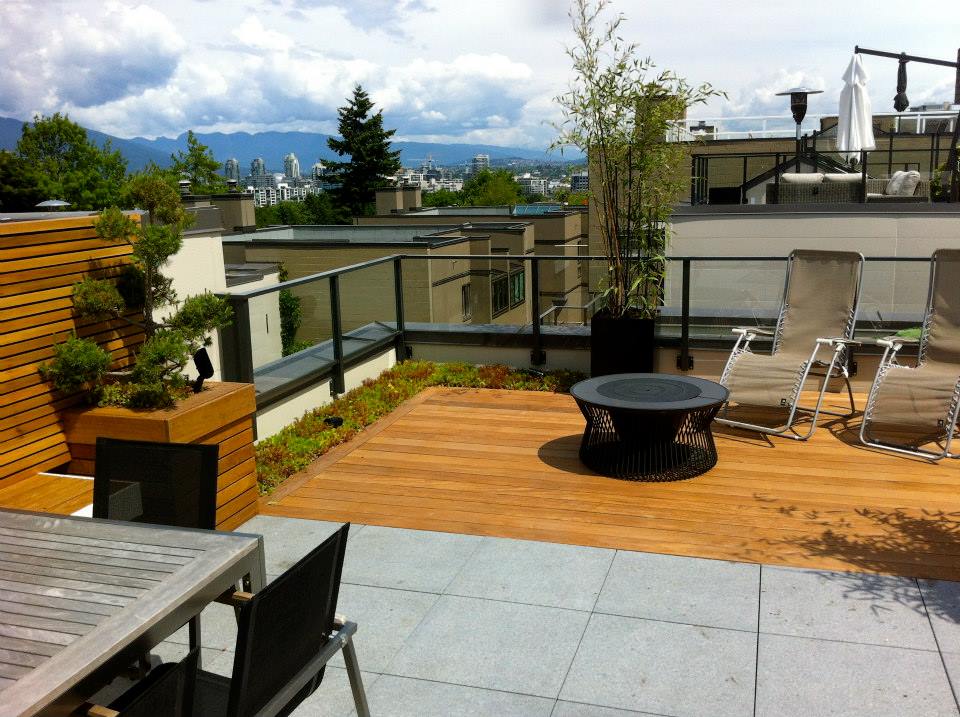 |
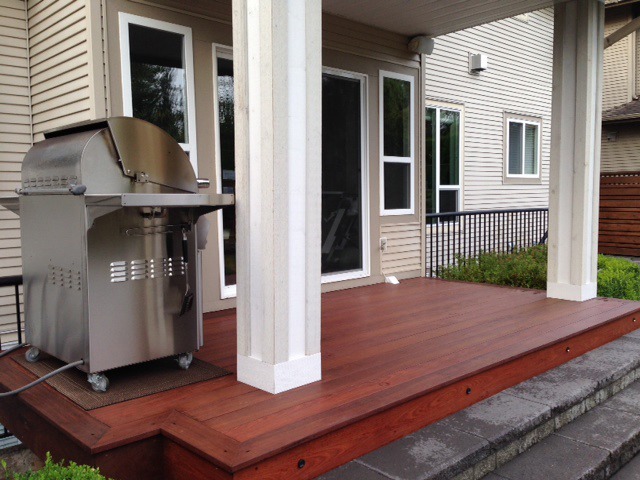 |
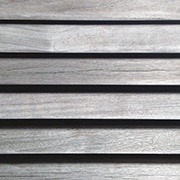 |
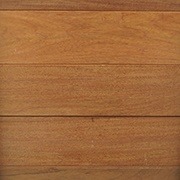 |
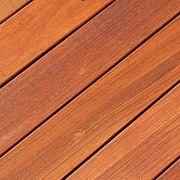 |
|
Weathered Ipe |
Raw Un-finished Ipe | Oiled Ipe |
Comparison: Western Red Cedar 350 Janka Hardness, 7,500 PSI Bending Strength
Tigerwood
Tigerwood is one of those woods that you either love – or hate. If consistency of colour is what you’re looking for, we’d advise against this particular wood as it can range from clear orangey tones, to planks with pronounced black stripes…like a tiger! Each batch of Tigerwood we supply for a custom deck is different to the next and makes this species an ideal choice for those wanting something unique and eye-catching.
It has a beautiful tight grain pattern, new wood darkens in direct sunlight before fading to a handsome silver patina similar to Ipe and other hardwoods (unless oiled to protect and preserve the colour). Tigerwood as a species is more likely to twist than Ipe – but as we’re demonstrating, all woods are susceptible to a similar problem from time to time. A Bowrench is a handy tool for installation of Tigerwood decking (as well as other species, including softwoods like Cedar). Check out this useful YouTube video for a demonstration or click this link to find out more about other Hardwood Decking Essentials
JANKA HARDNESS
|
BENDING STRENGTH
|
LIFESPAN
|
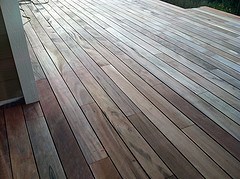 |
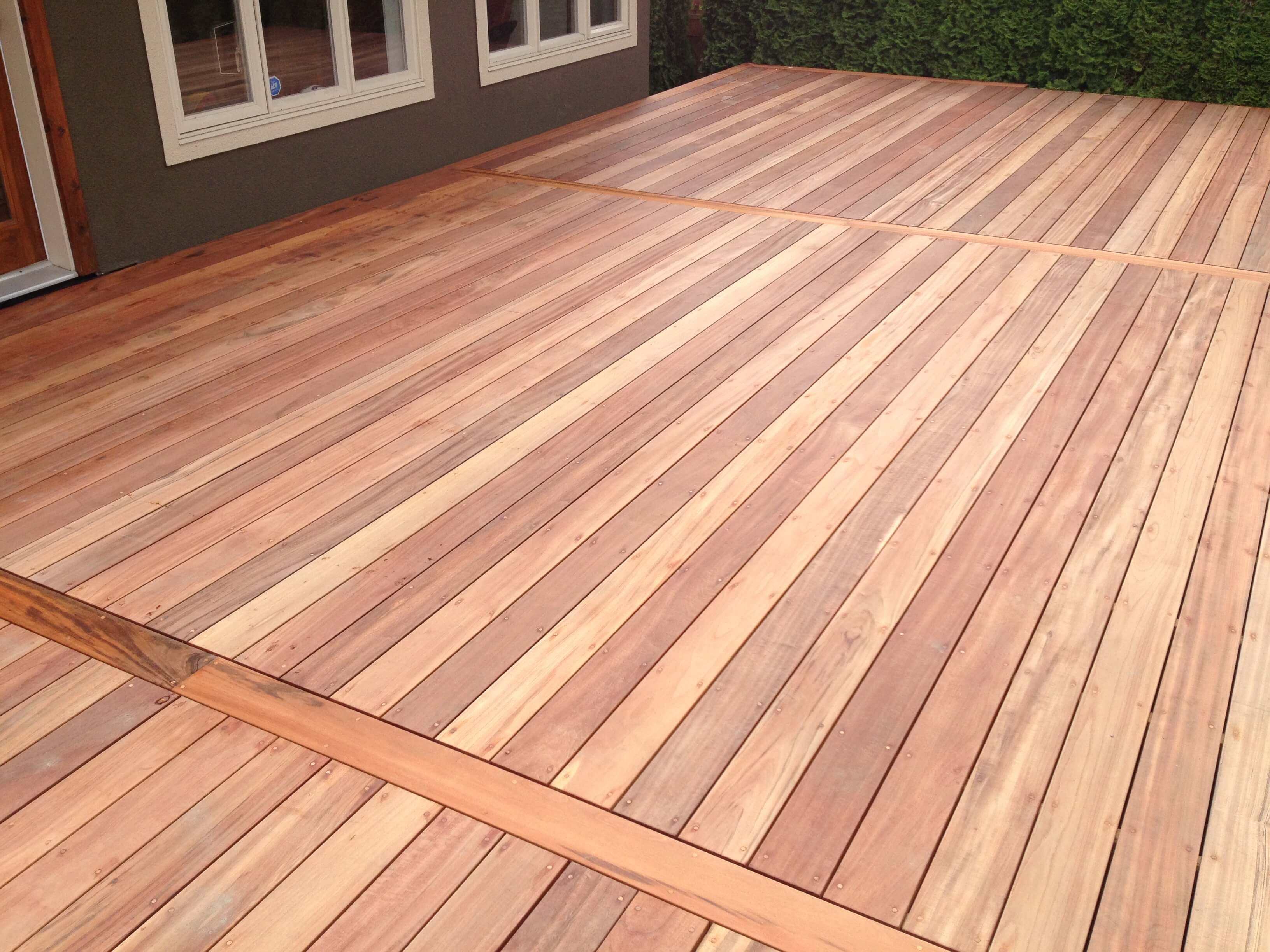 |
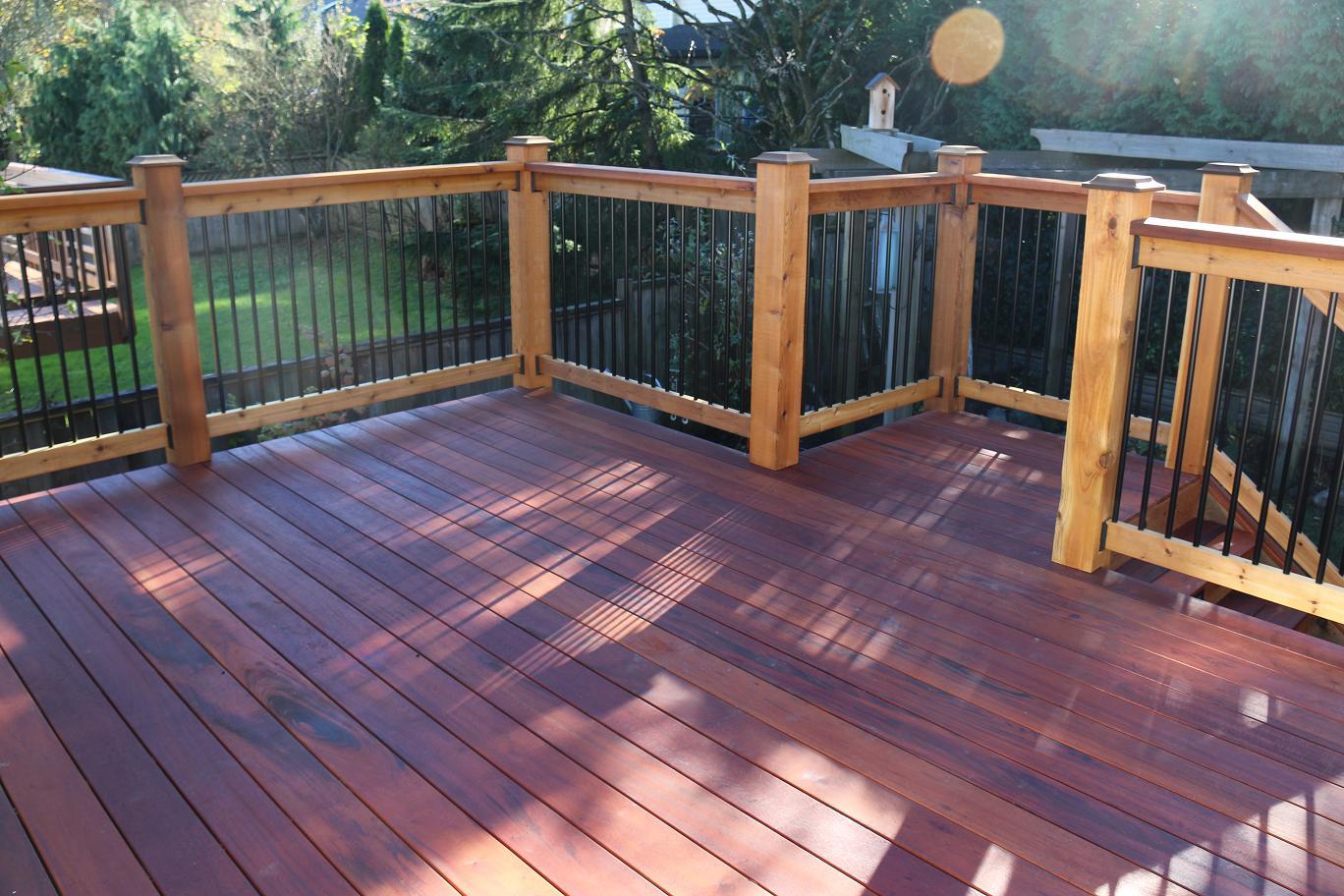 |
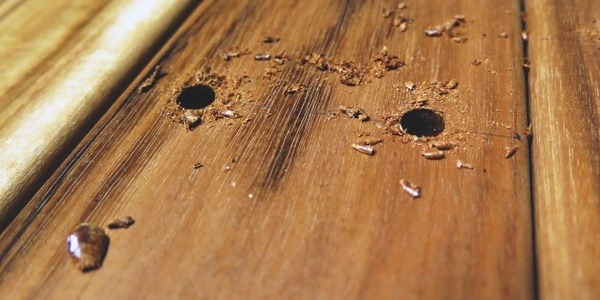 |
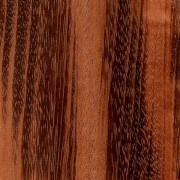 |
|
|
Weathered Tigerwood |
Raw Un-finished Tigerwood | Oiled Tigerwood |
Red Balau (Batu)
Red Balau has a looser grain pattern than either Ipe of Tigerwood and it is therefore more common to see this wood split, crack or produce very short, fine slivers (splinters) either on new or weathered wood. It is for this reason that Batu is considered the ‘entry-level’ into hardwood decking and is therefore suitable for those people who want a similar rich lustre to Ipe, but at a fraction of the cost. We recommend sanding and oiling Batu all the way around with a coat of Penofin Hardwood formula to prevent slivers and minimize splitting or checking. As with all Hardwoods, coating any cut ends with a wax emulsion such as Anchorseal II is a must – and this product can also be used widely to minimize checking in all species of wood, as well as form a clear protective barrier on the ends of Composite decking such as Trex or TimberTech
JANKA HARDNESS
|
BENDING STRENGTH
|
LIFESPAN
|
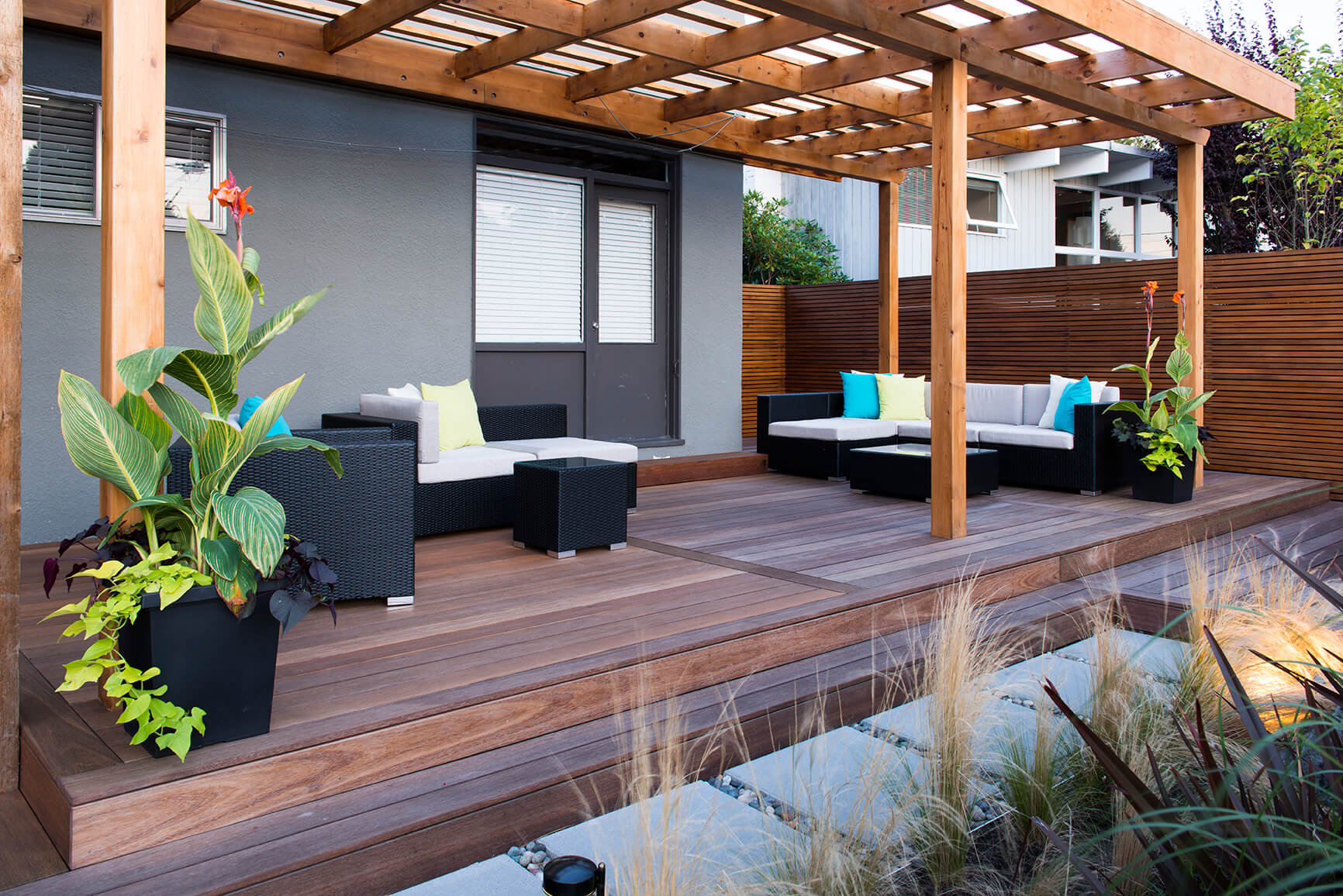 |
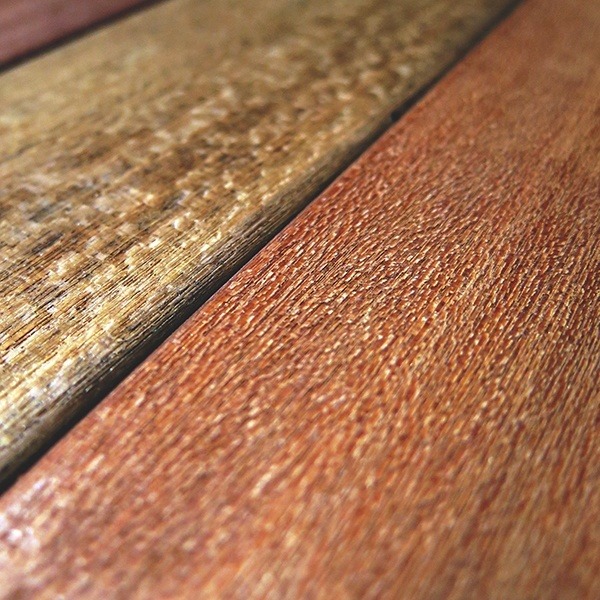 |
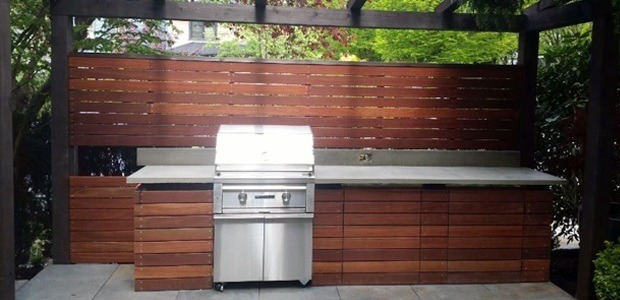 |
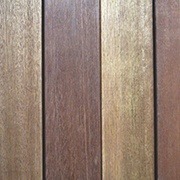 |
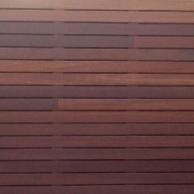 |
|
|
Weathered Batu |
Raw Un-finished | Oiled Batu |
CHARACTERISTICS OF WEATHERED HARDWOOD
In their raw state hardwoods exhibit rich natural tones and lustre which is part of their appeal. With prolonged exposure to UV rays the natural colour will eventually bleach and fade to a handsome silver patina. Even the pronounced black stripes of the aptly named Tigerwood will fade, giving the wood a more consistent colouration over time.
Over time – and depending on the grain pattern of each plank, some pieces will exhibit small hairline fractures as the natural oils dry out from the wood. These are not ‘defects’ – they are simply characteristics of all wood species that is exposed to changing weather conditions. Of course some planks do split in a way that compromises structural integrity, but this is a characteristic of all natural fiber and should be expected from time to time.
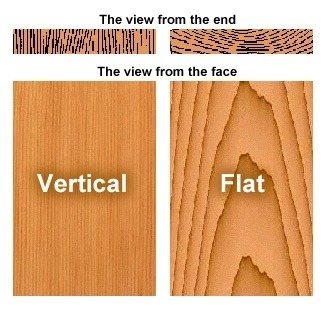
For example – an experienced decking installer will understand how to use the grain and pattern, crook or crown of a deck plank to prevent cupping. Similarly – they will know how to best work around any defects, to ensure minimal waste, or how to work with and incorporate naturally occurring crooks or bows in certain pieces of wood buy using the appropriate installation method or tool.
The important thing to note here is that between all grades of lumber – each one shares a common denominator. They are all natural fiber – and as such, they do not offer timeless perfection – but who wants perfection anyway, nature doesn’t promise perfection, and certainly when working with wood – perfection it’s overrated.
More Blog Articles Hardwood Decking Essentials Request A Quote



